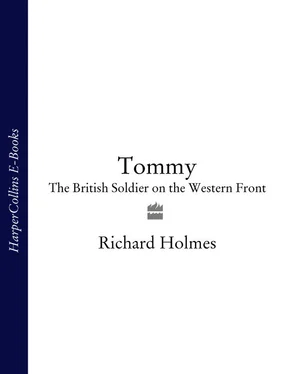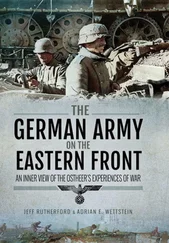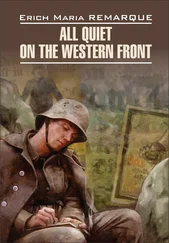Although he has been in France for about two years, most of the Germans Atkins has seen have been either dead or prisoners. There is certainly no mistaking this one’s purpose or determination. He has a trim beard, and wears a cap rather than the coal-scuttle helmets of the two soldiers behind him. A thick row of silver braid round his collar marks his rank; on his left breast is an Iron Cross. He fires his automatic pistol twice: time stands still as the empty cartridge cases catch the light as they spin up and away. There is a crash behind Atkins as Abraham falls forwards, hit in the chest, and then the German’s momentum carries him straight onto Atkins’s bayonet. He has no time to think, but leans forward onto his rifle, setting the bayonet firmly: he then gives it a quarter-turn (‘making the wound not only fatal, but immortal’, as base warriors, who have never seen a trench, like to say) and tugs it out easily enough. The German falls backwards with blood pulsing from his throat, but it is a measure of his resolve that he fires once more, at the very doors of death, missing Atkins by a hair’s breadth. Then he drums his heels on the duckboards and is still.
The other two Germans take the hint, drop their rifles and raise their hands, crying Kamerad. There is a deafening bang just behind Atkins as Jarvis shoots one straight between the eyes: only the seconds spent working his bolt to chamber another round enable Atkins to grab his rifle by the fore-end, jerk the muzzle upwards and yell: ‘No, no! They’ve jacked!’ Jarvis stops at once, like a drunk suddenly sobering up, turns to look at Abraham lying on the trench floor too obviously dead, swears, spits, slings his rifle and takes another grenade out of his waistcoat. He is just about to throw it when there is a loud shout of ‘Manchester, Manchester’ from behind the next traverse. And round it stalks a little corporal with a toothless grin, a grenade in his hand, and a lanky bayonet man behind him. ‘’Ello, choom,’ he says. The junction is complete. 1
The Western Front drew men of my grandfathers’ generation to it like a malign and irresistible magnet. During the course of the First World War about 4 million British soldiers served there. From March 1916 there were never less than a million on the Western Front, and the total peaked at 1,721,056 on 1 August 1917. Although this book is concerned primarily with the British soldier, it is important not to forget that the British Expeditionary Force in France contained substantial Empire and Dominion contingents (from India, Australia, New Zealand, Canada and South Africa), and adding these to the narrowly British figure sees the total number of men under British command top two million in the summer of 1917. 2Some 1,724,000 British officers and men were killed, wounded or reported missing on the Western Front, about five casualties for every nine men sent out. 3
Almost 400,000 Canadians went to France, where 210,000 were killed or wounded. Newfoundland, then not legally part of Canada, lost 3,661 casualties, not including Newfoundlanders serving, as many did, in other national contingents. The Australians, with over 300,000 men in France, suffered over 180,000 casualties, and the New Zealanders, with about 90,000 in Europe, almost 47,000. The Indian Army sent almost 160,000 men to France, and some 25,000 of them were killed or wounded. Although the bulk of South African soldiers fought in Africa, more than 14,000 were killed or wounded in France. There was inevitably friction between British and Dominion contingents, with Poms v. Aussies spats the best known. The tendency for popular history to emphasise national achievements at the expense of collective effort often makes it hard to remember that this was a giant imperial endeavour. But just as there was suffering and misery enough for all, so too ought the credit to be more evenly distributed.
From Britain’s point of view the Western Front was easily the most expensive of the war’s theatres: Gallipoli, the next most deadly (though it lasted less than a year), killed or wounded two of every nine men sent out. Although the Second World War was a far greater tragedy in human affairs (for instance, Russian military dead probably numbered 10 million) the British armed forces lost 264,000 killed in all theatres, far less than half those killed on the Western Front a generation earlier. The Western Front thus has the melancholy distinction of being the costliest theatre in which British troops have ever fought.
And yet the front needs to be kept in proper perspective. It would be wrong to suggest that it was more dreadful, in the First World War, than Gallipoli in its scorching, stinking summer or, on the Italian front, than the Julian Alps in mid-winter. And it would be equally wrong to rank it worse than some Second World War clashes, such as ‘The Kokoda Trail in New Guinea, flooded Dutch polders, the Hurtgen forest and the Reichswald, an Arakan monsoon, frozen foxholes in the Ardennes and the Apennines, the beaches of Tarawa and the putrid slime of Okinawa’. 4But what distinguishes the Western Front is its dreadful combination of loss of life, qualitative misery and its sheer, mind-numbing scale, made somehow more strange by its ‘ridiculous proximity’ to Britain.
In all, nearly 750,000 British and Commonwealth soldiers, sailors and airmen died on the Western Front. They rest in more than 1,000 military and 2,000 civilian cemeteries, Over 300,000 have no known graves, and are commemorated on Memorials to the Missing like the Menin Gate in Ypres and the Thiepval Memorial on the Somme. These cemeteries and memorials mark the course of the old front line as it weaves across Belgium and down into France, with concrete pillboxes, preserved (and some more evocatively unpreserved) trenches, whilst starkly rebuilt villages trace the war’s path.
The Western Front ran for about 460 miles, depending on the ebb and flow of battle, from the dunes of the North Sea coast, across alluvial Flanders, laced with drainage ditches and speckled with pollarded willows. Even the salient which bulged round the little Belgian town of Ypres had once looked handsome, as Lieutenant Guy Chapman reflected when he looked at it in the spring of 1917.
Two mornings later we sat on the Tower Hamlets ridge and surveyed the desolation. Many months hence, I was standing on this spot with a major in the Bedfords. ‘I was here in nineteen-fourteen,’ he said; ‘then you could not see half a mile for the woods.’ It was scarcely credible. In nineteen-seventeen, it was as bare as a man’s hand. It could not, one thought, ever have been otherwise. Could such destruction have been wreaked? Were these puke acres ever growing fields of clover, beet or cabbage? Did a clear stream ever run through this squalmy glen? This, the map tells you, was once a magnate’s estate. Now the lawns are bare of grass. The ornamental water has been replaced by more recent landscape gardeners; it is a quag of islands and stagnant pools, over which foul gases hang. 5
Henry Williamson, who knew the salient as a private in the London Rifle Brigade in 1914 and later as an officer in the Bedfords, observed that it:
had the outline of a skull, with teeth trying to crack Ypres … A fit man can easily walk round the skull’s outline in a day; but in ’17, could he have walked without human interference, he would have dropped exhausted, before he had finished a hundredth part of the way, and been drowned with his face under the thin top mud. 6
Graham Seton-Hutchison, infantry officer turned machine-gunner, mused on the way that nicknames, chosen when the world was green, now veiled nameless horrors. ‘God knows what cynical wit christened these splintered stumps Inverness Copse or Stirling Wood,’ he wrote. ‘And who ordained that these treacherous heaps of filth should be known as Stirling Castle or Northampton Farm?’ 7
Читать дальше












